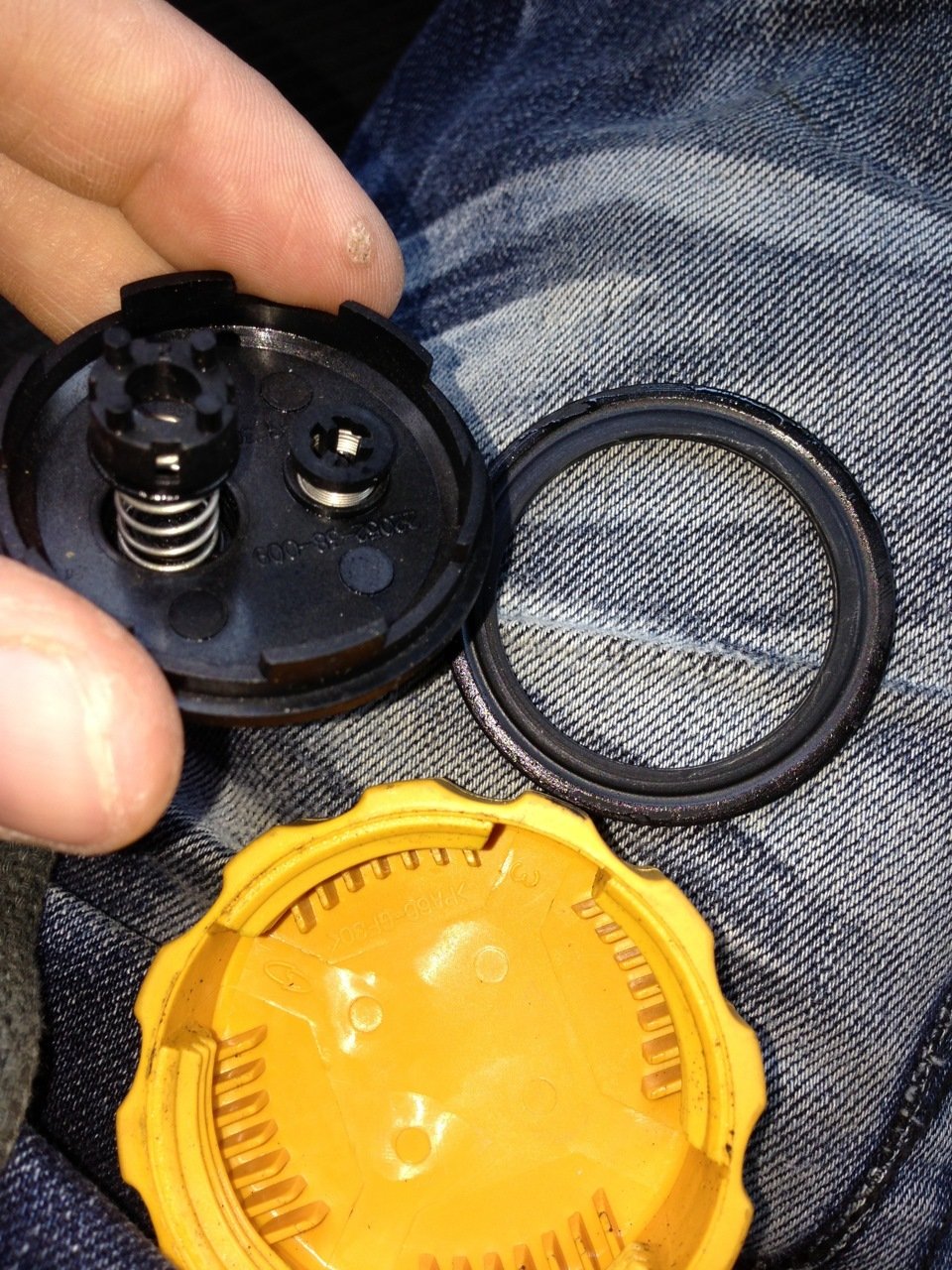
How to troubleshoot an expansion tank
Content
One of the elements without which the normal operation of the car's cooling system is impossible is the expansion tank. It is designed to compensate for the increase in the volume of antifreeze when heated and pressurized. As the vehicle is used, the container may fail. The tank is easy to replace or repair with your own hands.
What malfunctions can occur
The expansion tank of the cooling system has such a simple design that it does not even imply its possible breakdowns. It would seem that a plastic container with a lid, what is there to break? But it is with the lid that problems can sometimes arise. It contains a discharge valve, the correct operation of which directly affects the performance of the engine cooling system as a whole.
During the operation of the tanker, the following malfunctions may occur:
- rupture of the container body;
- the appearance of a coolant leak under the cover;
- shut-off valve malfunction or contamination.

In case of serious damage to the tank, for example, if it breaks, the container cannot be restored
Many car owners in the event of a lid or reservoir breakage simply buy a new part, due to its cheapness and availability. But if desired, these elements can be repaired - solder the bowl and clean the lid from dirt. If spots appear, then the reason, as a rule, comes down to a loose fit of the cover to the case due to design features.
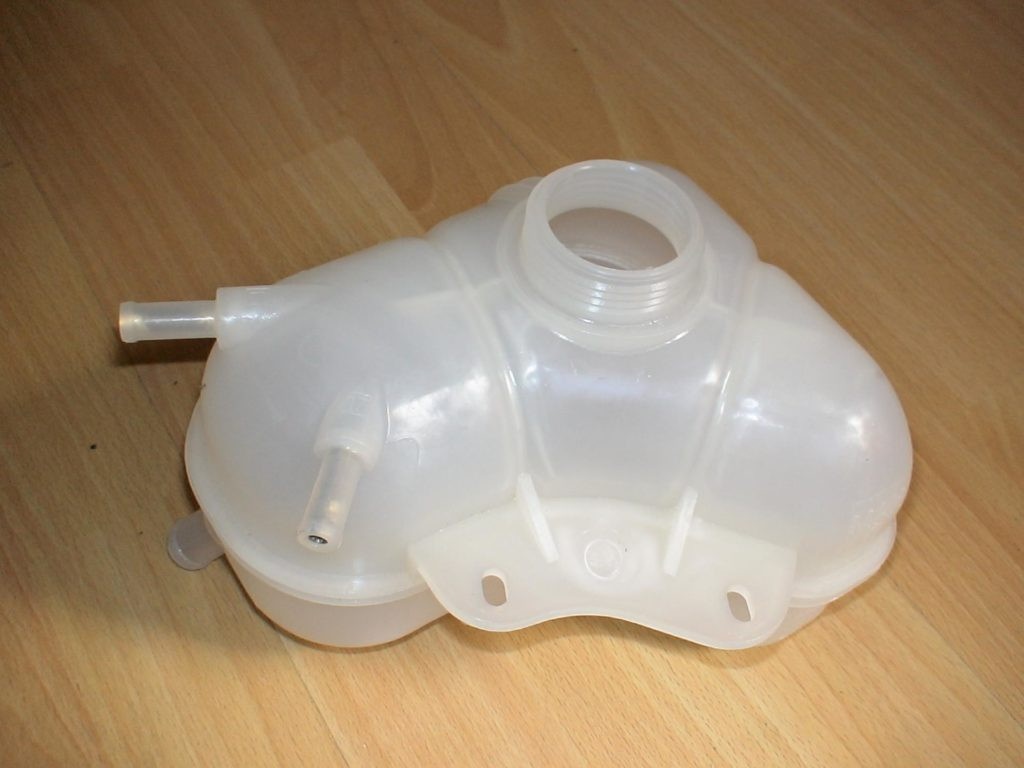
Most car owners buy a new part when a tank or cap breaks so as not to waste time repairing them.
How to check the expansion tank
A fairly common cause of container failure is the failure of a valve built into the lid. If the element does not work correctly, the engine cooling system starts to work incorrectly. In addition to the formation of air pockets, overpressure can occur, leading to rupture of the container. As a result, you have to change the tank to a new one. It is recommended to check the valve periodically to avoid engine damage.
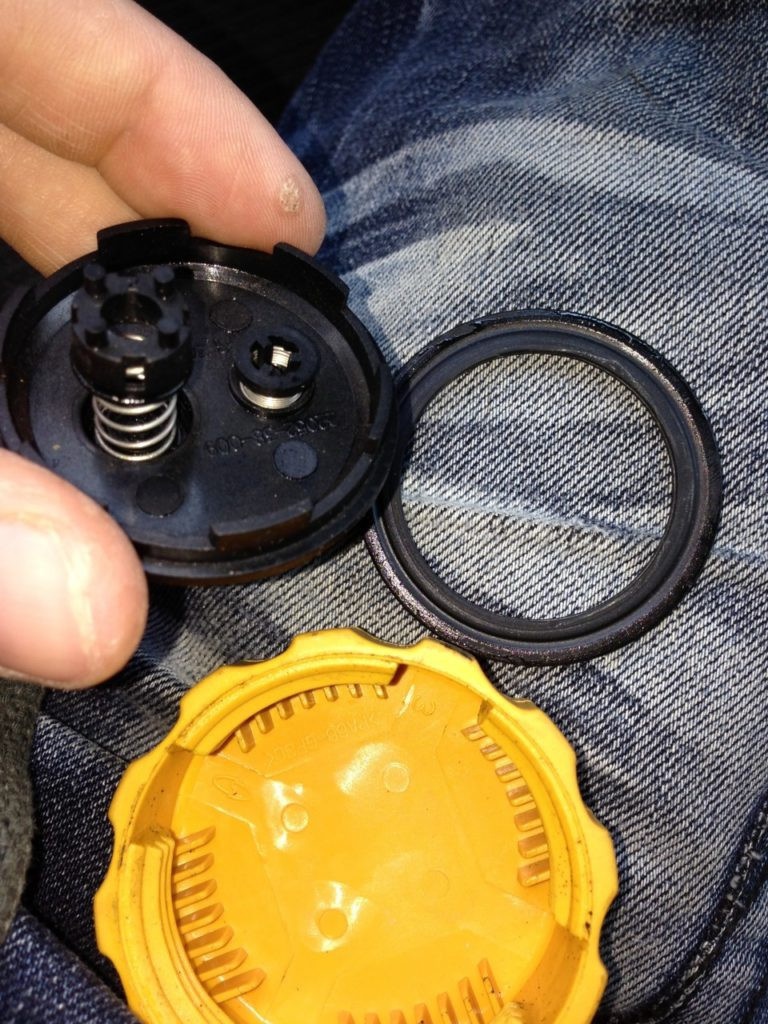
On the cover of the expansion tank there are valves that must open at a certain air pressure
The essence of the valve is that when the liquid is heated, strong pressure is created in the system. At some point, the valve on the expansion tank opens and releases air. When the system cools down, the reverse process occurs when air is sucked into the tank.
To check the valves on the cover, you will need a pump and a pressure gauge. To do this, remove the hose going to the cooling radiator from the thin upper fitting and attach the hose to the pump. As you pump air, you should monitor the pressure gauge and check the earplugs. The cylinder valve for venting must open at a pressure of 1,1-1,5 bar. At the same time, an increasing hiss of the cork is heard. In this case, the increase in pressure should stop.
If it is necessary to reduce the readings, the plug is disassembled and the thick spring is cut with wire cutters, bringing the value to the desired pressure. It is recommended to change the tank cap every two years to maintain optimum system pressure.
The appearance of cracks in the tank is indicated by the appearance of a coolant leak, an unpleasant odor is possible, since the antifreeze is in contact with the hot exhaust manifold. If damage to the housing is found, it is necessary to turn off the engine, wait for the coolant to cool, and then proceed to disassemble the element:
- release the fasteners from the container;
- unscrew the clamps and remove the hoses;
- disassemble the tank;
- drain antifreeze;
- find the problem area in the case.

To remove the expansion tank, you will need to unscrew the clamps and tighten the hoses
Breakdowns in the tank lead to its depressurization, as a result of which the coolant comes out. The main reasons leading to such consequences:
- excessively high pressure in the cooling system;
- containers with insufficient wall thickness (poor quality product);
- boiling antifreeze is in the tank for a long time;
- blows or other mechanical influences.
If an antifreeze leak is found, it is necessary to determine where it originated and repair or replace the container.
Expansion tank valve does not open
One of the reasons for the increased pressure in the cooling system is a valve malfunction in the cap of the expansion tank - it simply jams (sours). As a rule, the valve cannot be repaired and must be replaced. Although there are car owners who, using carburetor cleaning fluids, remove all deposits and restore the performance of the part.
High pressure in the system can lead not only to rupture of the expansion tank, but also to damage to the heater radiator, which once again confirms the need for regular checks of the valve. But the pressure can be not only high, but also low, which indicates insufficient tightness in the system. In this case, special equipment will be required, since it will be very problematic to find the cause at home.
Why is there oil in the expansion tank
Such a problem as the appearance of oil in the expansion tank is faced not only by owners of domestic cars, but also by foreign cars. The presence of the following factors in the boat indicates possible problems with the engine:
- an emulsion was found on the walls of the tank neck, which is formed when the refrigerant and oil are combined;
- the presence of an oil film on the surface of antifreeze;
- the appearance of an unpleasant odor and a change in the color of the liquid in the tank.
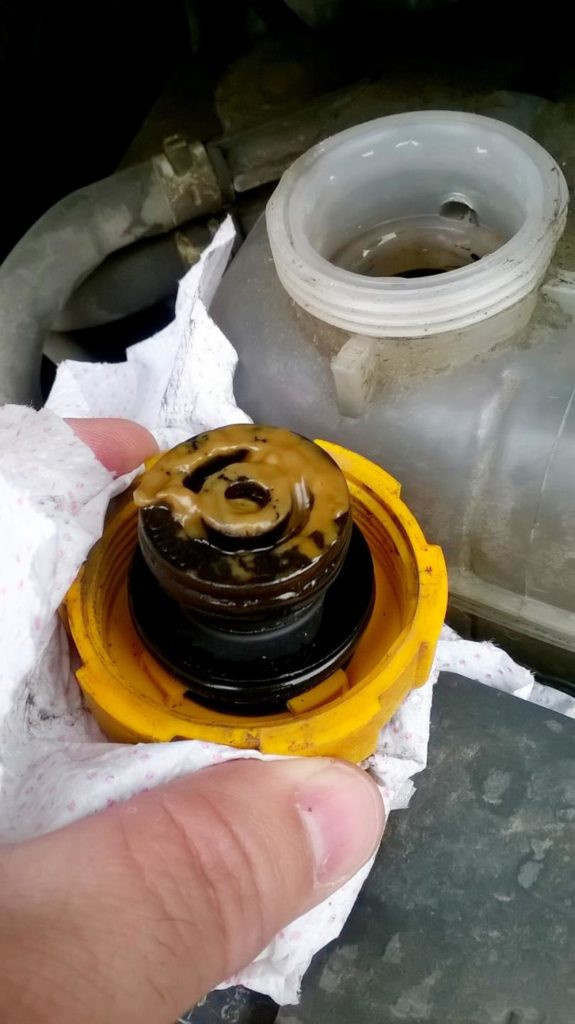
The presence of oil in the expansion tank (emulsion in the plug) is indicative of an engine problem that should be repaired as soon as possible to prevent serious engine damage.
If oil is still found in the tank, then most likely the engine will need to be repaired. This conclusion is explained by the fact that oil and coolant flow in the engine through different channels. If they connect, then the integrity of one of the channels is violated. But first you need to understand what can lead to such a situation.
The most obvious reasons:
- Faulty cylinder head gasket, damage to cylinder block or cylinder head. At the same time, gases, engine oil appear in the cooling system, and condensate is observed in the exhaust pipe. These signs indicate that the gasket is damaged and needs to be replaced.
- Damage to the heat exchanger. The pressure in the lubrication system is higher than in the cooling system, which can cause oil to seep into the heat exchanger. This is due to wear of the gasket (breakage, hardening). The item is not repairable and needs to be replaced.
- Mixing different antifreezes. As you know, antifreeze comes in different classifications and you should not mix the first liquid that comes across with the one used in the car. The fact is that the coolant has differences both in composition and in class. It is impossible to mix antifreezes of different colors, since the composition of the liquids is different, and the additives contained in it can enter into a chemical reaction, which will lead to unpredictable consequences.

The appearance of oil in antifreeze may be due to damage to the heat exchanger gasket, which will require its replacement
How to check the expansion tank cap
The expansion tank cap is an important detail. If it does not work properly, the antifreeze may boil, which will cause a leak. To avoid problems in the future, you need to know how to check the cap for possible problems. Let's briefly consider the sequence of actions:
- We inspect the part for possible damage (scratches, cracks).
- The main elements of the cap are a spring, fasteners and a metal cap. An important element is the spring, which should not compress easily.
- To test this, you can put the cap in your mouth and inhale into yourself. If air enters easily, then the valve is working. Otherwise, the spring will jam.
- This can also be checked with a pressure gauge pump. The pump is connected to the upper thin fitting and air is sucked in. When a pressure of 1,1–1,5 bar is reached, the air must be bled off. During normal operation of the valve, the pressure in the system is maintained within the specified limits.

To assess the performance of the cover, a visual inspection is carried out and the pressure of the element is checked using a compressor and pressure gauge.
Why does antifreeze kick out of the expansion tank
During the operation of the car, you may encounter such a problem as the release of coolant from the reservoir. The main reason for this phenomenon is the wear of pipes and other elements of the system. Since the hoses operate at high pressure and high temperature, over time, their integrity is compromised, resulting in fluid leakage from the tank. But this problem is not limited to used cars. In new cars, due to failures in the tank, antifreeze also disappears. The reason for this is the poor quality of parts or a manufacturing defect. If there are burrs on the neck of the container, the lid will not seal properly. As a result, the liquid is forced out through this gap.
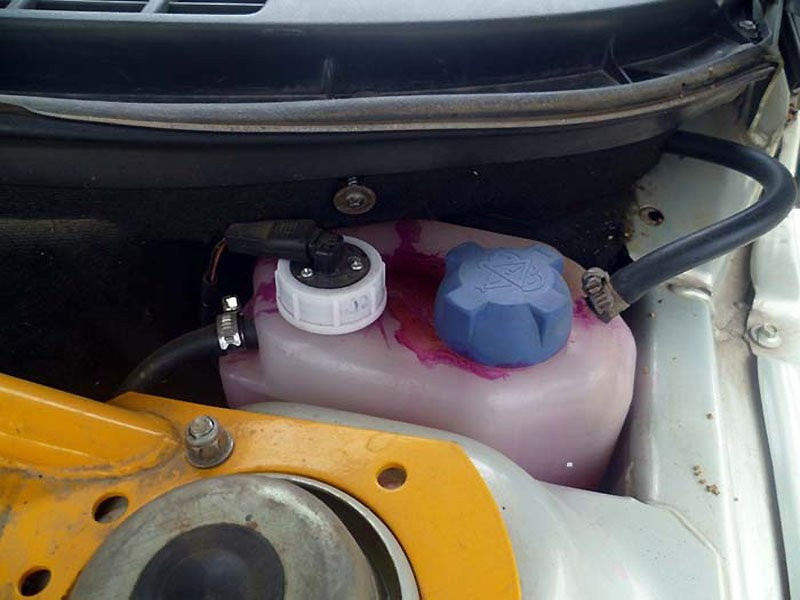
Antifreeze may leak from the expansion tank due to a leak in the cap due to a factory defect in the element
There are situations when a crack appears in the tank itself. The reason, as a rule, is the low quality of the plastic and the high pressure in the cooling system. However, antifreeze from the tank may leak as a result of boiling, which is associated with vehicle malfunctions that lead to engine overheating. One problem could be a faulty thermostat, a clogged cooling radiator, or a faulty pump.
Reasons for boiling antifreeze and the appearance of foam in the expansion tank
Antifreeze or antifreeze, compared to water, is a liquid that has a higher boiling point and a lower freezing point. However, under heavy loads, the liquid may boil, which some motorists have to deal with. There may be several reasons for this:
- Insufficient coolant level in the tank and, as a result, overheating and boiling. You can get out of the situation by adding liquid to the desired volume, but you need to find out why the level has dropped.
- Thermostat failure. If the unit does not work properly, the liquid circulates in a small circle, due to which the antifreeze gurgles in the expansion tank. This is due to the fact that the liquid simply does not have time to cool down when passing a small circle. For diagnostics, you need to find two tubes coming out of the thermostat. If the engine warms up to operating temperature and one hose is hot and the other is cold, then the reason is clear: the thermostat does not open.
- High pressure in the cooling system. It is possible to identify that the problem is precisely in excess pressure by the temperature sensor in the cabin: if the readings are normal, but the antifreeze is boiling, the reason is overpressure.
- Problems with the performance of the cooling radiator. Such a phenomenon as boiling antifreeze is especially important in the summer heat when idling in traffic jams. To eliminate boiling, it is enough to turn off the engine and stand for a while. Also, the radiator may be dirty, which reduces the speed of movement of the liquid inside. You can try to remove the contamination by washing with both special and improvised means.

With an insufficient level of coolant in the tank, overheating and boiling of antifreeze occur.
If the antifreeze in the tank foams, then there are two main explanations for this:
- Low quality coolant.
- Damage to the gasket between the cylinder head and the cylinder block.

Foam may appear in the expansion tank, which is associated with the use of low-quality antifreeze or damage to the cylinder head gasket
In the case of low-quality coolant, the foam is easy to remove with your own hands. It is enough to drain the bad antifreeze from the system, pour a solution of citric acid with distilled water. In this way, you can remove the remnants of low-quality liquid. If the gasket is damaged in the tank, small bubbles first appear, and then large bubbles. Gradually, a foamy mass is formed.
There is only one way out in this situation - to replace the gasket, that is, you need to remove the head from the block. In the worst case, it may be necessary to replace not only the gasket, but also the head, which is associated with overheating and cracking. Cracks will also contribute to foaming. Depending on the brand of car, repairs can be quite expensive. Therefore, it is not worth delaying the solution of such a problem.

Cracks in the cylinder head lead to the appearance of foam in the expansion tank, which indicates the need for a serious engine repair
Do-it-yourself expansion tank repair
During operation, the expansion tank is constantly subjected to deformation: the container narrows and expands due to temperature changes; this is his mode of operation. At maximum values, cracks appear on the walls of the tank. The problem can be solved in two ways: buy a new tank or repair the old one.
expansion tank crack
The material used in the manufacturing process of the expansion tank does not react with any adhesive, regardless of the brand. This suggests that when gluing, it will not be possible to repair the tank in a quality manner. Those car owners who decide to restore performance, as a rule, resort to the following methods:
- weld cracks in the body with a metal mesh;
- use epoxy, special sealant or cold weld.

Due to the constant impact on the expansion tank of high pressure and temperature, cracks appear in the vessel over time
It's worth noting that cold welding and epoxy only solve the problem temporarily, and you still have to come in to repair or replace the tank.
Some motorists are wondering how and with what to repair cracks in the plastic housing of the expansion tank. To perform the procedure at home, you must:
- wipe the box in the place of the crack with a clean rag or napkin;
- degrease the area with a solvent, then dry;
- cut a piece of brass mesh with small cells along the damage;
- stick a strip on the place of repair;
- weld the mesh to the edges of the crack with a heated soldering iron in such a way that a reinforced layer is formed over the entire area of \uXNUMXb\uXNUMXbthe mesh;
- grind the seam;
- apply putty, a layer of primer and paint.
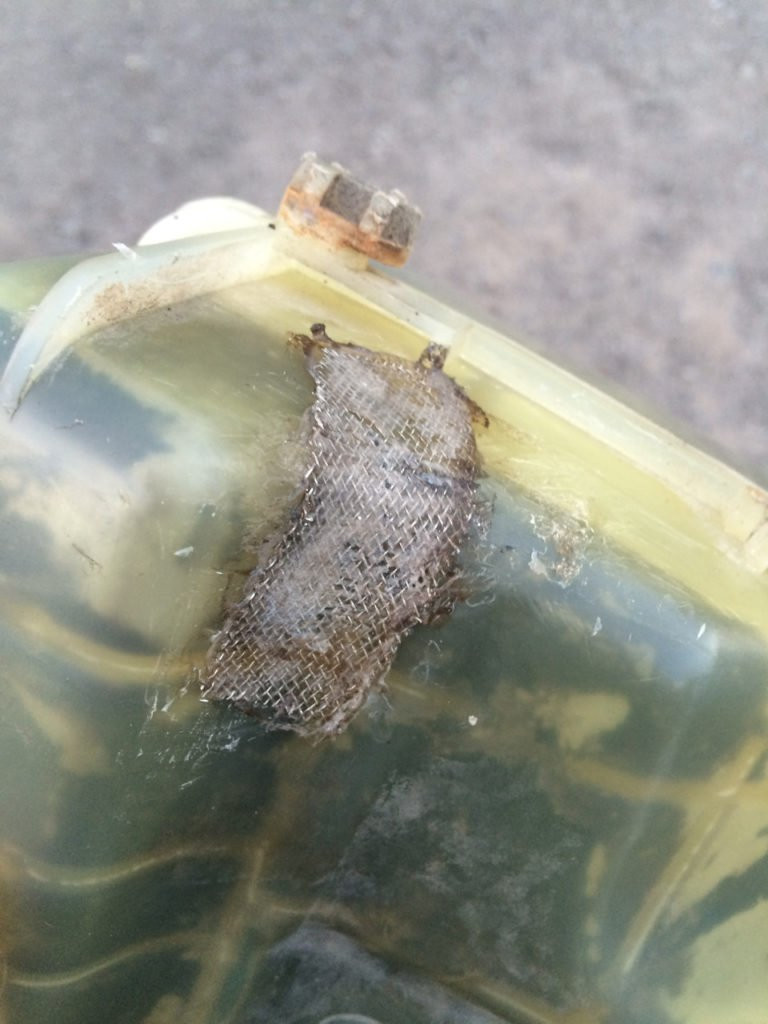
The most common and cheapest way to restore the expansion tank is welding with a fine metal mesh
For this procedure, you will need a soldering iron with a power of at least 40 W with a flat tip. You can restore the tightness of the tank with a special red Done Deal sealant, which is designed for plastic. Before applying the substance, the body is thoroughly cleaned and degreased.
How to clean the expansion tank inside
The expansion tank of the cooling system during operation can become dirty not only from the outside, but also from the inside. If it is not so difficult to wash the container from the outside, then it is quite troublesome to clean it from the inside. Contaminants are of a different nature: sediment, scale, oil, etc., so even the liquid level in the tank may not be visible. To remove contamination, first of all, it is necessary to remove the container from the car. Depending on the layout, the dwelling can be divided into partitions, which complicates the cleaning process. Through the cork hole, you can try to remove dirt with improvised means, for example, wrap a wooden stick with a rag, stick it inside and wipe off the dirt.
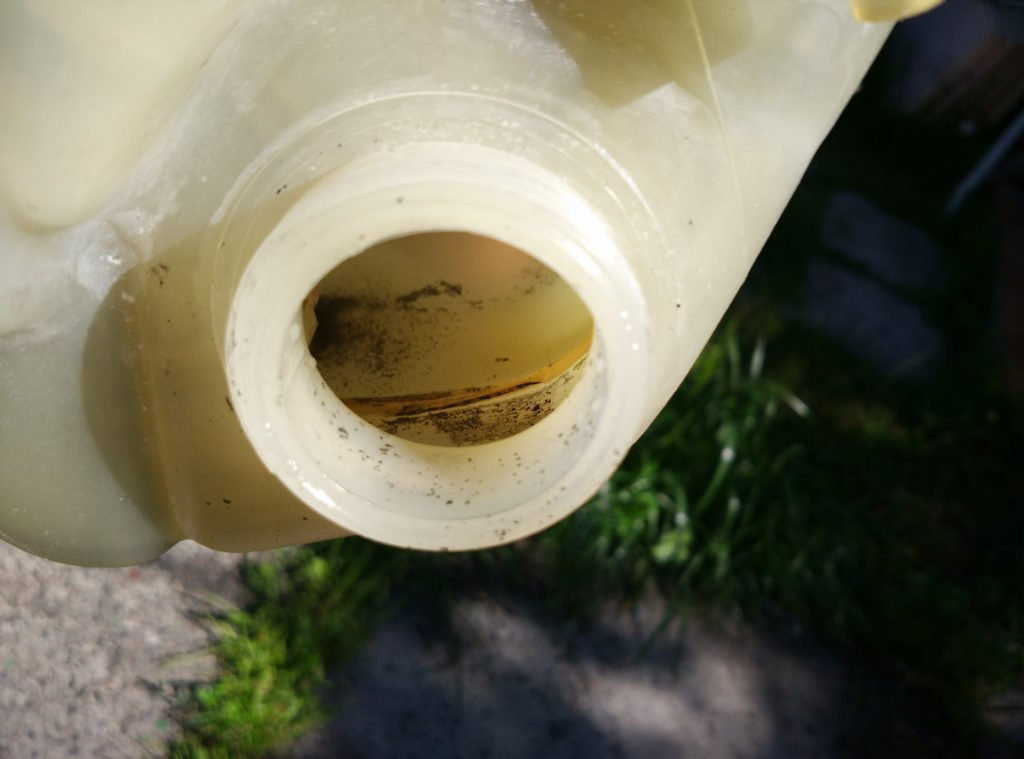
Sometimes it becomes necessary to clean the expansion tank as a result of its contamination. For these purposes, you can use improvised means and materials, as well as special liquids.
Depending on the type of soiling, citric acid, washing powder, kerosene, or mineral spirits may help. There is another option - a mixture of powder, gasoline and warm water, which is poured into the tank, the holes are closed and left for a day. Shake the container periodically. Some car enthusiasts pour some sand into the container and shake it clean, but perfect cleaning is not always possible. If none of the above helped, they resort to the use of modern chemicals, the variety of which today will satisfy the needs of any car owner.
The expansion tank of the cooling system is a reliable part. However, there are times when capacity issues arise. In order not to resort to premature replacement of the tank, it is recommended to periodically check the operation of the valves in the lid. By having a repairable part, it will be possible to avoid rupture of the high pressure housing.